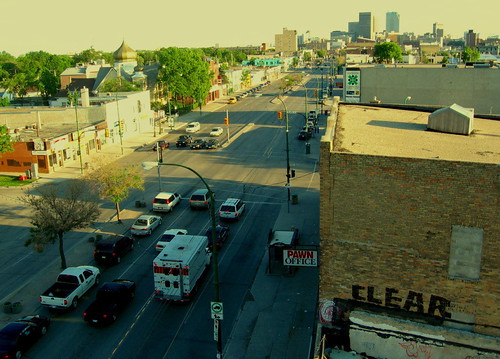Old buildings worth more than their form
 At the corner of Main Street and Pritchard Avenue, two kilomotres from Portage and Main, a four storey mixed-use apartment building is set to be demolished. A fire occured inside earlier this year, and it has been vacant since. The ground level is encircled by chain link fence, and spray-painted tags of the demolition company festoon the old shop windows. (Perhaps someone shold call the graffiti hotline on Imirie Demolition Company.)
At the corner of Main Street and Pritchard Avenue, two kilomotres from Portage and Main, a four storey mixed-use apartment building is set to be demolished. A fire occured inside earlier this year, and it has been vacant since. The ground level is encircled by chain link fence, and spray-painted tags of the demolition company festoon the old shop windows. (Perhaps someone shold call the graffiti hotline on Imirie Demolition Company.) Architecturally speaking, this building is anonymous: another modest brick building constructed sometme between 1900 and '20, of which Winnipeg has scores. The cornice is gone, replaced by corrugated tin, and the shopfronts and suites were probably in need of repairs, even before the fire. Compared to the soaring terra-cotta temples of finance downtown, this building is positively bland. But this building is much more than its architectural merit: it makes Winnipeg what it is (and could be); what sets our old city apart from every other city in Western Canada. Like our other great resource, nearby lakes and beaches, we pollute our urban neighborhoods with neglect. And like with them, we then turn around and complain with wonder when they decline and become more unfit for use and enjoyment. All across the city, numerous other non-descript old buildings--even in the Exchange District--are being threatened, usually for the purpose of more parking, because they are not lucky enough to receive relative and ambiguous labels like "significant" and "historical." With so many grand heritage buildings in Winnipeg, the thinking goes, why care so much about the small, plain ones? Who cares about the Bell Hotel when we still have the Royal Albert Arms? Why save the Avenue when the Paris is right next door?
Greater than it's embellishments, style, or architect, this building at Pritchard and Main successfully incorporates and helps to create Jane Jacob's four conditions for city diversity, outlined in her 1961 magnum opus, The Death and Life of Great American Cities: mixed-use buildings; small city blocks (North End blocks are only slightly larger than the average Greenwich Village block); aged buildings; concentration (this building sits along a corridor of a major commercial street in William Whyte, one of the city's most densely populated neighborhoods). These are decidedly the things we should be building much more of (like the mixed-use condominiums on Waterfront Drive are an attempt at doing), not destroying. Once they're gone, it seems unlikely they will come back anytime soon. On the opposite corner of Pritchard and Main, a dismal strip mall clad in stucco serves as a reminder of what today's design qualities leave us with.
Economic realities, however, can't be ignored any more than the realities of urban planning and preservation can. Low property values make demolition the more financially sound option for owners of fire-damaged buildings, while stable property values encourage rehabilitation. A sufficient transit system would also ensure that buildings like this, and locations like Pritchard and Main, would offer to residential tenants convenience, and to commercial tenants customers. (Of course, both stable property values and quality transit existed here at one time; this building would not have been built if they did not.) Both are needed now, the former, of course, not likely to arrive without the construction of the latter.
And for those concerned smarty-pants that would call property values rising out of depression gentrification, believe that this would be inherently bad for everyone, and should not be allowed to occur (except perhaps in the neighborhoods south of Portage Avenue where they happen to live and shop), consider this: a wealth of mixed-use apartments on transit routes would go far in dealing with the so-called affordable housing crisis.


0 Comments:
Post a Comment
Subscribe to Post Comments [Atom]
<< Home